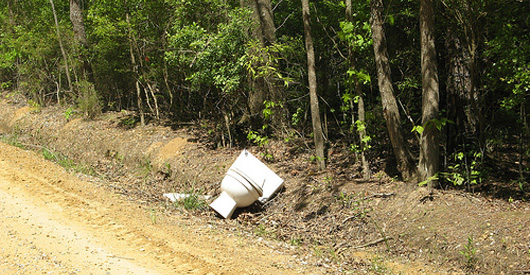If you live in an older home or apartment, the toilet in your bathroom uses between three to four gallons of water each time you flush. In fact, your toilet is the “largest daily user of water” in your home. Some water conservationists respond by only flushing down bowel movements and posting signs for visitors reading: “If it’s yellow let it mellow; if it’s brown flush it down;” however, the smell and sight of a urine filled toilet is not pleasant. New installations and remodeling projects are left with two flushing options: low-flow toilet or dual flush toilet.

Toilets manufactured after 1992 are mandated by US federal law to “to meet or beat” efficiency standards of 1.6 gallon per flush. Once considered the “bane of the bathroom“, early low-flow toilets had a bad reputation for requiring multiple flushes to get solids down, thus frustrating consumers and not conserving water in the process. Newer models are much more efficient, and many allow consumers to adjust the water output to the perfect amount for their personal use. Instead of relying on gravity, like older toilets, new low-flow toilets may use pressurized air.
Dual flush toilets are different than low-flow toilets in that they give you two options for flushing. DIY Network explains, “The world’s driest continent — Australia — brings us dual-flush toilets, which give you a choice: push one button for flushing liquid waste (.8 gallons of water) and another for solid waste (1.6 gallons).” DIY eco-friendly dual flush toilet retrofit kits are available, or you can buy a toilet that is already equipped with this option.
We recently put an addition on our house, and both of our bathrooms feature each kind of water conserving toilet described above. Our low-flow toilet was very expensive. At first we hated it, as it used such little water that the toilet bowl was always dirty. We then discovered the water adjustment, and we have had no more problems.
Our dual flush toilet was a one-fifth the cost of the low-flow toilet, as we were able to buy it at a large warehouse store versus a local plumbing supply shop. Although it is better to shop local, sometimes you have to save money when doing home repairs. We are happy with our dual flush toilet, but in the middle of the night, I just press whatever button without paying attention. I suppose as I become more familiar with the toilet, I’ll remember which button to use.
Of course, you can avoid water consumption all together by installing a composting toilet, but low-flow and dual flush toilets are more acceptable to many people. ABCs of Toilets reports that if everyone switched to water-efficient fixtures, we could reduce water consumption by 30%. In these times of pressure on dwindling fresh water supplies and reservoirs dropping to 40% of capacity, we all should be using water conserving toilets.

You must be logged in to post a comment.